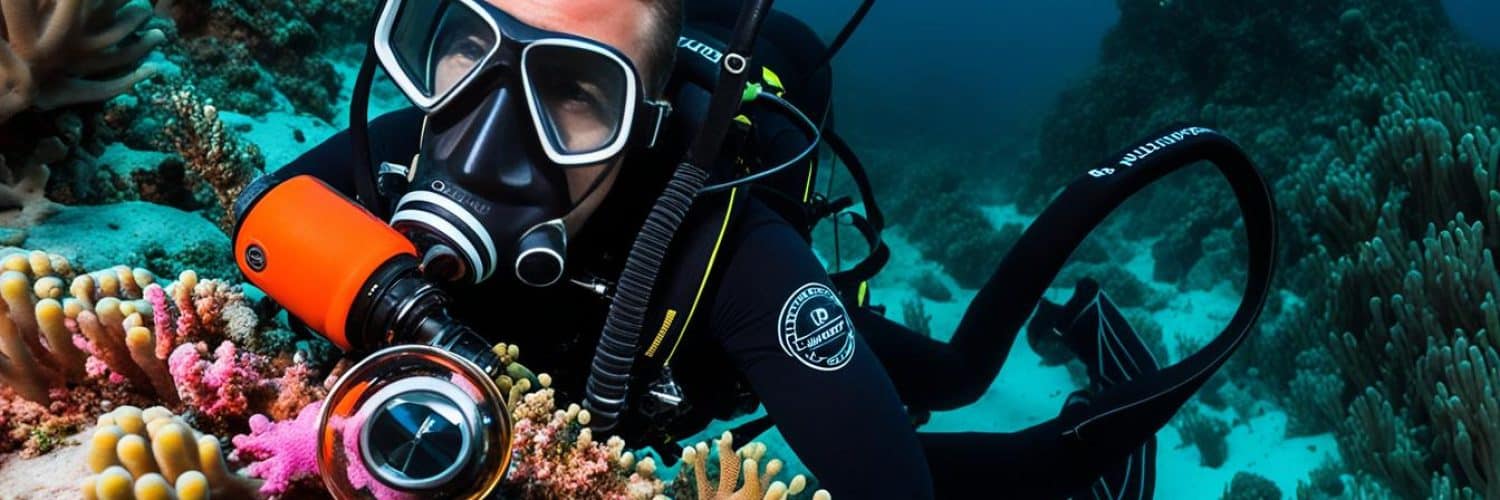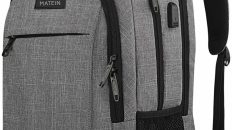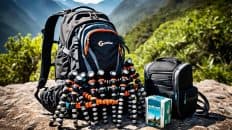When it comes to scuba diving, having a reliable and high-performance octopus regulator is essential for every diver. Whether you’re a beginner or an experienced diver, finding the best travel octopus regulator can enhance your diving experience and ensure your safety underwater.
So, what makes a travel octopus regulator the best choice for divers? It should be affordable, durable, lightweight, and easy to use. Additionally, it should provide reliable performance and deliver effortless breathing in any diving conditions. With these factors in mind, we have curated a list of top-rated travel octopus regulators that check all the boxes.
Key Takeaways:
- Choose a travel octopus regulator that is reliable, high-performing, and affordable.
- Look for a durable and lightweight design that is easy to transport.
- Prioritize easy breathing and optimal performance in any diving conditions.
- Consider the type of gas you will be using and the number of ports the regulator has.
- Ensure the regulator is suitable for your diving environment, whether it’s cold or warm water.
What to Look for When Buying a Scuba Regulator
When purchasing a scuba regulator, there are several factors to consider. One of the main considerations is whether you need a DIN or yoke regulator, which depends on where you will be diving and the type of tanks available.
You should also consider the water temperature, as regulators need to be suitable for diving in cold water. Ease of breathing is another important factor, as you want a regulator that allows for effortless breathing without resistance.
“Choosing a scuba regulator that is appropriate for the water temperature you’ll be diving in is crucial for your comfort and safety. Cold-water diving requires regulators that can withstand low temperatures and prevent freezing, while warm-water diving may not have such requirements.”
The type of gas you will be using and the number of ports on the regulator are also worth considering. The gas used can affect the performance of the regulator, so it’s important to choose one that is compatible with the type of gas you plan to dive with. The number of ports determines how many additional devices you can connect to the regulator, such as an alternate second stage or a drysuit inflator hose.
If you are a frequent traveler, it’s advisable to choose a lightweight regulator that is easy to transport. This will make your diving trips more convenient and hassle-free.
Key Considerations When Buying a Scuba Regulator:
- Type of regulator: DIN or yoke
- Water temperature: Cold or warm water diving
- Ease of breathing: Smooth and effortless airflow
- Type of gas: Compatibility with the gas you plan to use
- Number of ports: Sufficient ports for your diving setup
- Regulator weight: Lightweight for easy travel
By considering these factors, you can make an informed decision when buying a scuba regulator that best suits your diving needs and preferences.
Choosing the Right Price Range for Your Scuba Regulator
When it comes to purchasing a scuba regulator, finding the right price range for your budget is crucial. Consider the features and quality of regulators within your desired price range to ensure you make the best choice. Here are three price ranges to consider:
Budget Scuba Regulator
If you’re just starting out or have a limited budget, there are budget-friendly scuba regulators available. These regulators typically offer basic features and functionality at an affordable price. They are ideal for recreational diving in warmer waters and are priced up to around $350.
Mid-Range Scuba Regulator
If you’re looking for a balance between affordability and performance, consider a mid-range scuba regulator. These regulators offer a wider range of features and may include advanced technology for enhanced breathing comfort and ease of use. Mid-range regulators are priced between $350 and $799.
High-End Scuba Regulator
For divers who prioritize top-notch performance and durability, investing in a high-end scuba regulator is worth considering. These regulators are built with advanced materials, innovative designs, and precision engineering to deliver exceptional performance even in demanding diving conditions. High-end regulators are priced above $799 and are suitable for divers who frequently explore colder waters or are pursuing advanced diving certifications.
It’s important to note that the price range of a scuba regulator doesn’t always indicate its quality. There are budget regulators that still perform well and meet the needs of recreational divers. However, if you plan on diving in colder water or advancing in your diving career, investing in a higher-end regulator may offer additional benefits in terms of durability, performance, and breathability.
Take your time to research and compare regulators within your desired price range to find the perfect scuba regulator that meets your needs and enhances your diving experience.
Diving in Cold or Warm Water: Environmental Considerations
If you’re planning to dive in water colder than 57°F (14°C), it’s important to consider a scuba regulator that is suitable for cold-water diving. Cold-water diving refers to diving in water below 60°F (15°C). In such conditions, specific features in a regulator become crucial to ensure a safe and comfortable dive.
An environmentally sealed regulator is a key feature to look for when diving in cold water. This type of regulator helps prevent freezing of the internal mechanism, ensuring consistent and reliable performance even in low temperatures. It provides an extra layer of protection against the elements, giving you peace of mind during your dives.
Another important consideration for cold-water diving is opting for a metal second stage. Metal second stages have better thermal conductivity compared to plastic, reducing the risk of freezing even further. This ensures a smooth and uninterrupted airflow, allowing you to breathe comfortably throughout your dive.
On the other hand, any scuba regulator should be suitable for diving in warm water. So if you’re diving in warmer conditions, you can focus on other important factors without worrying about the specific cold-water diving features.
Benefits of Environmentally Sealed Regulators for Cold-Water Diving:
- Prevents freezing of the internal mechanism
- Ensures consistent and reliable performance
- Additional protection against cold-water elements
Advantages of Metal Second Stages for Cold-Water Diving:
- Better thermal conductivity compared to plastic
- Reduced risk of freezing
- Uninterrupted airflow for comfortable breathing
Ease of Breathing: Finding a Regulator That Delivers
When it comes to scuba diving, ease of breathing is of utmost importance. You want a regulator that allows you to breathe effortlessly, ensuring a comfortable and enjoyable diving experience. Whether you’re a beginner or a seasoned diver, finding the right scuba regulator can make all the difference.
One type of regulator that is known for delivering smooth airflow is the piston-driven regulator. These regulators are designed with simplicity in mind and offer a larger volume of air to the second stage, making breathing feel easy and natural.
On the other hand, unbalanced regulators may require more effort to breathe as you descend deeper. As the water pressure increases, you may experience increased breathing resistance, making it more challenging to inhale and exhale comfortably.
To overcome this challenge, balanced regulators are recommended, especially for deeper dives. Balanced regulators provide consistent airflow regardless of the water depth and pressure. They are designed to deliver optimal performance and ensure ease of breathing, allowing you to focus on exploring the underwater world.
It’s important to choose a trusted brand when selecting a scuba regulator. Avoid inexpensive knock-off regulators that may not meet safety standards and compromise your breathing experience. Opt for regulators from reputable manufacturers who have a track record of producing high-quality, reliable equipment.
Key Takeaways
- Piston-driven regulators deliver smooth airflow, providing ease of breathing.
- Unbalanced regulators may require more effort to breathe as you descend deeper.
- Choose balanced regulators for consistent airflow under all conditions, recommended for deeper dives.
- Prioritize trusted brands to ensure the safety and reliability of your scuba regulator.
| Regulator Type | Ease of Breathing |
|---|---|
| Piston-driven Regulators | Smooth and effortless |
| Unbalanced Regulators | May require more effort as depth increases |
| Balanced Regulators | Consistent airflow under all conditions |
Understanding the Different Types of Gases Used with Regulators
When it comes to scuba diving, understanding the different types of gases used with regulators is essential for a safe and enjoyable experience. From enriched air nitrox (EANx) to decompression diving, there are various considerations to keep in mind when selecting a regulator that suits your diving needs.
EANx: Exploring the Benefits of Enriched Air Nitrox
Enriched Air Nitrox (EANx) is a popular gas choice among divers looking to extend their no-decompression limits. By increasing the percentage of oxygen and reducing the nitrogen content in the breathing gas mixture, EANx allows for longer dives and shorter surface intervals. Most scuba regulators are safe to use with EANx up to 40%, making it accessible to certified divers.
By using EANx, divers can calculate the best gas mix for their planned dive depth and duration, maximizing their bottom time while minimizing the risk of decompression sickness. However, it is crucial to undergo proper training and obtain EANx certification before using this gas mixture.
Decompression Diving: Considering the Use of Higher-Percentage Oxygen
Decompression diving involves longer and deeper dives, requiring additional safety measures. One such measure is the use of higher-percentage oxygen during decompression stops. Higher-percentage oxygen allows for more effective off-gassing of nitrogen from the body, reducing the risk of decompression sickness.
When planning for decompression diving, it is important to consider the compatibility of your regulator with higher-percentage oxygen. A DIN regulator, which offers a more secure connection than a yoke regulator, is often recommended for this type of diving. However, it is important to note that decompression diving requires specialized training and experience before attempting.
Choosing a regulator that accommodates higher-percentage oxygen and is suitable for decompression diving is crucial for ensuring your safety underwater.
EANx and decompression diving require additional training and certification to ensure a safe and enjoyable diving experience.
Comparing EANx and Decompression Diving
| Aspect | EANx | Decompression Diving |
|---|---|---|
| Gas Mixture | Increased oxygen, reduced nitrogen | Higher-percentage oxygen for decompression stops |
| Training | Requires EANx certification | Specialized training for decompression diving |
| Benefits | Extended dive times, reduced surface intervals | Optimized off-gassing, reduced risk of decompression sickness |
| Regulator Compatibility | Most scuba regulators up to 40% | DIN regulator recommended |
Understanding the different types of gases used with regulators is crucial for choosing the right equipment and ensuring a safe diving experience. Whether you’re exploring the benefits of EANx or considering decompression diving, always prioritize training and certifications to dive responsibly.
The Importance of Ports on a Scuba Regulator
When it comes to scuba diving, having the right equipment is crucial for a safe and enjoyable experience. One essential component of a scuba regulator is its ports. These ports serve as connection points for various diving equipment and instruments, allowing divers to customize their setup according to their specific needs.
Scuba Regulator Ports:
Scuba regulators typically come equipped with four low-pressure ports and two high-pressure ports. These ports play different roles in the functioning of the regulator:
- Low-Pressure Ports: The four low-pressure ports are used to connect the second stage, alternate second stage, inflator hose, and potentially a drysuit. These connections ensure the proper flow of air and control of equipment during the dive. If you dive with a drysuit, you will need an additional low-pressure port for inflating the suit.
- High-Pressure Ports: The two high-pressure ports are dedicated to specific instruments. One port is utilized for the submersible pressure gauge or console, which displays the remaining air pressure in your tank. The other high-pressure port can be used for future attachments like dive computers or transmitters.
Having an adequate number of ports on your scuba regulator is essential to accommodate your diving setup. It allows you to connect all the necessary equipment and instruments without any compromises.
“A properly configured regulator with the right number of ports ensures optimal functionality and convenience during your dives.”
Choosing the Right Scuba Regulator with Ports
When selecting a scuba regulator, it’s important to assess your diving requirements and equipment needs. Consider the following factors when evaluating the port configuration of a regulator:
- Type and Number of Connections: Determine the equipment you will be attaching to your regulator and ensure that the regulator has sufficient low-pressure ports to accommodate those connections. If you plan to dive with a drysuit or other specialty gear, check if the regulator has additional low-pressure ports to handle those requirements.
- Future Expansion: If you anticipate adding devices like dive computers or transmitters in the future, make sure the regulator has an available high-pressure port for such attachments.
- Compatibility: Different brands and models of regulators may have varying port configurations. Ensure that the regulator you choose is compatible with your existing equipment or the equipment you intend to use in the future.
Visualizing Scuba Regulator Ports
Here is a table summarizing the typical port configuration on scuba regulators:
| Port Type | Quantity | Usage |
|---|---|---|
| Low-Pressure Ports | 4 | Connect the second stage, alternate second stage, inflator hose, and potentially a drysuit. |
| High-Pressure Ports | 2 | One port for submersible pressure gauge or console, and another for future attachments like dive computers. |
Note: The table provides a general overview of scuba regulator port configurations and may vary depending on the specific regulator model.
By understanding the importance of ports on a scuba regulator and carefully considering your diving requirements, you can select a regulator that offers the necessary convenience and flexibility for your underwater adventures.
Considering the Weight of a Travel Octopus Regulator
When it comes to travel diving, weight plays a significant role in choosing a regulator. If you travel frequently for diving, it’s important to consider the weight of the octopus regulator and ensure that it is lightweight and easy to transport.
Some regulators are specifically designed for travel and are made from lightweight materials without compromising performance. These lightweight scuba regulators are the perfect choice for divers on the go, offering both convenience and reliable functionality.
“Choosing a lightweight scuba regulator is essential for travel divers who want to explore the underwater world without unnecessary equipment bulk.”
Lightweight scuba regulators are crafted from advanced materials that reduce their overall weight while maintaining durability. These regulators are meticulously designed to provide excellent performance and comfort, offering effortless breathing and a streamlined diving experience.
With a travel octopus regulator, you can confidently explore diverse diving destinations without worrying about the weight and inconvenience of traditional regulators.
Benefits of Lightweight Scuba Regulators
- Easy to pack and carry, making them ideal for travel divers
- Minimize baggage weight to save on airline fees
- Comfortable to use during extended dive trips
By choosing a lightweight scuba regulator, you can focus on enjoying your diving adventures without being weighed down by bulky equipment.
The Ideal Travel Companion
Travel octopus regulators are the perfect choice for divers who prioritize lightweight gear without compromising on performance and reliability. With their innovative designs and durable construction, these regulators offer peace of mind, knowing that you have a trustworthy scuba regulator for your travel diving needs.
Experience the freedom and convenience of a travel octopus regulator, allowing you to explore the underwater wonders around the world with ease.
Final Thoughts
When selecting a travel octopus regulator, consider its weight as a crucial factor. Look for regulators specifically designed for travel, made from lightweight materials without compromising on performance. By choosing a lightweight scuba regulator, you can enjoy hassle-free diving experiences wherever your underwater adventures take you.
Overview of Top Picks for Best Travel Octopus Regulator
After considering all the factors mentioned above, we have compiled a list of the top-rated travel octopus regulators on the market. These regulators have been chosen for their affordability, reliability, and high-performance. Whether you are a beginner or an experienced diver, these octopus regulators are suitable for all divers who prioritize ease of breathing, lightweight design, and durability. The top picks include regulators from reputable brands that have been tested and trusted by divers worldwide.
When it comes to traveling and diving, it’s essential to have a reliable and high-performance octopus regulator that can provide the air you need in any diving situation. The top-rated travel octopus regulator is designed to meet the needs of divers who want a compact and lightweight option without compromising on performance.
Affordable and Reliable Travel Octopus Regulator
For those on a budget, the affordable travel octopus regulator is a great choice. It offers reliable performance without breaking the bank. This regulator is suitable for divers who want a solid and dependable option that won’t cost a fortune.
High-Performance Travel Octopus Regulator
If you prioritize high-performance and are willing to invest in a top-of-the-line regulator, the high-performance travel octopus regulator is the ideal choice. It offers exceptional breathing comfort, durability, and advanced features that cater to the needs of experienced divers.
“The top-rated travel octopus regulators provide divers with the peace of mind they need when exploring the underwater world. These regulators have been carefully selected based on their ability to deliver reliable performance in various diving conditions.”
When choosing the best travel octopus regulator, it’s important to consider your diving needs and preferences. Factors such as ease of breathing, weight, durability, and affordability should all be taken into account. By selecting one of our top picks, you can ensure that you have a reliable and high-performance octopus regulator that will enhance your diving experience.
Conclusion: Finding Your Must-Have Octopus Regulator for Divers
In conclusion, choosing the best travel octopus regulator requires careful consideration of various factors. Firstly, consider the type of diving you will be doing – whether it’s in cold or warm water. This will help determine the features you need in a regulator, such as environmental sealing for cold-water diving.
Ease of breathing is another crucial factor to consider. Look for a regulator that delivers air smoothly and effortlessly, ensuring a comfortable diving experience. Additionally, take into account the gas requirements and the number of ports your regulator needs to accommodate.
Another important consideration is the weight of the regulator, especially if you travel frequently for diving. Opt for a lightweight travel octopus regulator that is easy to transport without compromising on durability and functionality.
By considering these factors and exploring our top picks, you can find the must-have octopus regulator that meets your needs as a diver. Remember to prioritize performance, reliability, and comfort while staying within your budget. Happy diving!
FAQ
What factors should I consider when buying a scuba regulator?
When buying a scuba regulator, you should consider whether you need a DIN or yoke regulator, the price range, the water temperature you will be diving in, ease of breathing, the type of gas you will be using, the number of ports on the regulator, and the weight of the regulator if you’ll be traveling frequently.
What is the difference between a DIN and yoke regulator?
A DIN regulator is a screw-in type that offers a more secure connection and is popular in Europe. A yoke regulator is a clamp-type that is commonly used in the United States. The choice between the two depends on where you will be diving and the type of tanks available.
What should I consider when diving in cold water?
When diving in water colder than 57 F (14 C), it’s important to choose a scuba regulator that is suitable for cold-water diving. Look for regulators that are environmentally sealed to prevent freezing of the internal mechanism and consider a metal second stage, which has better thermal conductivity and helps prevent freezing.
What is the importance of ease of breathing in a scuba regulator?
Ease of breathing is crucial in a scuba regulator, as you want a regulator that allows for effortless breathing without resistance. Piston-driven regulators deliver a larger volume of air to the second stage and are known for their simplicity, while balanced regulators provide consistent airflow under all conditions and are recommended for deeper dives.
Can all scuba regulators be used with enriched air nitrox?
Most scuba regulators can be used with enriched air nitrox (EANx) up to 40% once you are trained and certified. However, for decompression diving with higher-percentage oxygen, you may need to consider the compatibility of the regulator and choose a DIN regulator.
How many ports should a scuba regulator have?
Scuba regulators typically have four low-pressure ports and two high-pressure ports. The low-pressure ports are used to connect the second stage, alternate second stage, inflator hose, and potentially a drysuit. The high-pressure port is used for the submersible pressure gauge or console.
What should I consider when choosing a travel octopus regulator?
When choosing a travel octopus regulator, consider the weight of the regulator, as you’ll want one that is lightweight and easy to transport. Look for regulators specifically designed for travel, made from lightweight materials without compromising performance.
Which travel octopus regulators are recommended?
We have compiled a list of top-rated travel octopus regulators on the market. These regulators are affordable, reliable, and high-performance. They prioritize ease of breathing, lightweight design, and durability. You can find our top picks from reputable brands that have been tested and trusted by divers worldwide.







Add comment